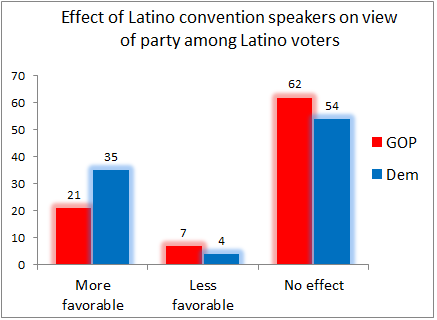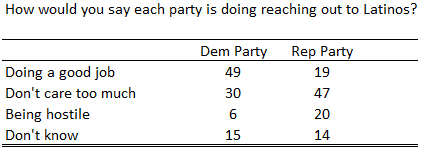Latino political leaders were on display at the 2012 political conventions like never before. The Republican convention featured two Latino Governors and two Latino U.S. Senators (with the impending election of Ted Cruz in Texas). The Democrats countered with a Latino chairman of their entire convention and a Latino keynote speaker on opening night. The Republicans asked their Latino star Marco Rubio to introduce their candidate Mitt Romney in primetime, and the Democrats invited an undocumented Latina DREAMer to address the crowd. All told, Latinos figured prominently into both the RNC and DNC conventions but how much sway did these performances have with the average Latino voter? Depends on if you’re a glass half-empty or glass half-full kind of pundit.
Following each convention, the impreMedia/Latino Decisions weekly tracking poll asked Latino voters what they thought of the Martinez y Rubio show in late August and the Villaraigosa y Castro duo in early September. Overall, a majority of voters told us that the inclusion of Latino faces at the convention did nothing to sway their vote, however among those who were influenced the reactions were quite positive in both cases.
It would be foolish to expect a three-day event full of pomp and circumstance to do much to change anyone’s mind on issues of party attachment, which are deeply held and usually long lasting. But it was important for both parties to make an effort to improve their image and outreach to the fastest growing segment of voters in virtually every state – Latinos. With an estimated 23 million Latino citizen adults eligible to vote, getting the attention of this emergent demographic is crucial.
Overall, when asked, about the RNC inclusion of Susana Martinez and Marco Rubio, those who said it influenced their opinion of the Republican party were much more likely to say it gave them a favorable impression – 21% more favorable to 7% less favorable. Still a large majority (62%) said it had no effect on how they viewed Republicans. Encouragingly for Republicans, larger positive ratings came from Latino independents, where 38% said more favorable to only 8% less favorable, a +30 margin after seeing Martinez and Rubio headline the RNC.
In comparison the Democrats inclusion of Antonio Villaraigosa and Julian Castro scored even higher marks from Latino voters. Of those who said they were influenced by the Latinos on stage at the DNC, 35% said it made them more favorable compared to just 4% less favorable, and 54% who said it had not effect on how they viewed Democrats. Compared to the RNC, Latino Independents were slightly less impressed by the Democrats efforts with 26% saying more favorable and 5% less favorable, a +21 margin. Not surprisingly, co-partisans were the most impressed with their parties efforts, with Democrats giving the DNC a 50% to 3% advantage and Republicans giving the RNC a 43% to 6% advantage after their efforts at Latino outreach.

So what does this mean? While neither party scored a perfect 100, they both earned positive marks for their efforts at Latino inclusion and outreach. While it’s clear the Republican have far more work to do on mending their image with Latinos, the Democrats also need to increase their efforts and not take the Latino vote for granted. The impreMedia/Latino Decisions tracking poll for September 10, 2012 shows both parties have work to do in connecting with Latino voters. When asked to evaluate not the conventions, but the overall outreach efforts by each party, 19% of Latinos judged the Republicans were doing a good job and 49% said the Democrats were doing a good job. In contrast 47% said the Republicans “don’t care” about Latinos and worse, 20% said Republicans were “being hostile” towards Latinos. For Democrats 30% agreed that the party doesn’t care about Latinos and 6% thought Democrats were hostile.

We’ve said repeatedly that Latino voter turnout and enthusiasm is going to be critical in 2012, and the data back this up. Even small fluctuations in projected Latino turnout causes states like Colorado and Virginia to oscillate between Romney and Obama (check the different scenarios on our Latino Vote Map w/ partner America’s Voice). Elsewhere, if Latino turnout is low Obama will likely lose Nevada, and if Romney can make some gains among Latinos in Florida he can win the sunshine state. So connecting with Latino voters, and making us feel welcomed and wanted in each political party or campaign goes a long way in increasing enthusiasm. According the what Latino voters are telling us, the conventions were an okay start at Latino inclusion, but there is a long, long way to go – not just until November 6, but until 2016, 2020, 2024 and beyond.

